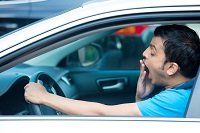
Most people are aware of the dangers of distracted or intoxicated driving. However, there is another form of dangerous driving that causes countless injuries and deaths on the roadways. A new report by the Governors Highway Safety Association (GHSA) found an average of 328,000 U.S. traffic accidents result from drowsy driving every year.
The GHSA reports that, of the 328,000 yearly fatigued driving accidents, an average of 109,000 result in injury and 6,400 result in fatalities. The report also states that drowsy driving accidents tend to occur in the late night to early morning hours or in the mid-afternoon on high speed roadways with drivers driving alone.
The problem does not appear to be going away any time soon. Americans continue to struggle to get enough shut-eye while handling all of their responsibilities. The 2015 Traffic Safety Culture Index by the AAA Foundation reveals that over 31 percent of drivers admitted to having difficulty keeping their eyes open behind the wheel within the past 30 days.
While you might think that you got enough sleep last night to safely take that road trip, it is important to note that even two fewer hours of sleep per night can result in more dangerous driving. Drowsy drivers are prone to:
Anyone is capable of drowsy driving. However, drivers between 19 and 25 are the most likely to drive drowsy.
Drivers under 25 are involved in over half of drowsy driving accidents every year. Teens and young adults require 8.5 to 9.5 hours of sleep, but their stressful schedules and use of technology prevent them from getting enough sleep.
It may be hard to believe, but the effects of drowsy driving can mirror those of drunk driving. Driving after being awake for 21 hours or more mimics driving with a blood alcohol content of .08. Going 24 hours without sleep is similar to having a BAC of .10.
All drivers have a responsibility to themselves and other motorists to be fully alert behind the wheel. Follow these tips to avoid drowsy driving:
If you or a loved one is ever involved in an accident with a drowsy driver, call the attorneys at Goldstein & Bashner for help recovering compensation: 516-874-4362.